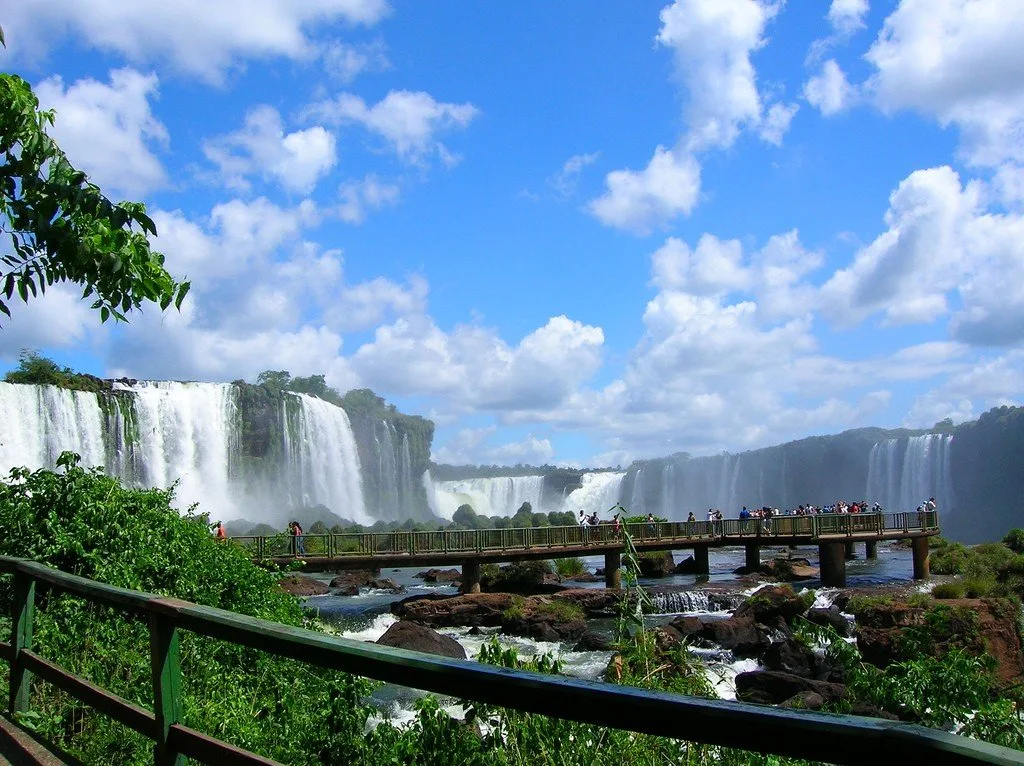"Poor Niagara!" - exclaimed Eleanor Roosevelt, barely glancing at the Iguazu Falls. This breathtaking natural spectacle is located on the border of Brazil and Argentina.
 |
| Iguazu Falls Iguazu River |
The riot of natural elements struck the eyes of more than one first lady: here, to the Iguazu Falls, tourists from all over the world seek.
General Information
In the language of the local Guarani tribe, who lived for centuries on the banks of the Iguazu River, this name means "Big Water" (y guaso). The river flows here for 2.7 km and forms a cascade of 270 separate waterfalls on the border of a 75 m deep fault. This fault is called Gargantadel Diablo (“Devil's Mouth”). Local tribes have composed a lot of naive tales, legends and myths about the appearance of the "Big Water". The most poetic of them is the legend of the beautiful daughter of the leader, the young Naipi. Here's how it sounds:
 |
| Iguazu Falls Iguazu River |
On the banks of the Iguazu River lived a beautiful daughter of a chief named Naipi. She fell in love with the bravest warrior in their tribe. But alas, they have already promised to give her as a wife to the divine snake M'bon. In desperation, Naipi and his warrior got into a canoe and sailed along the river, which was then quiet and peaceful. But suddenly M'boy woke up to find that his fiancee had run away. In a rage, he collapsed as hard as he could into the river. The force of the impact broke the earth, and the water rushed into a deep depression. M'boi turned the brave warrior into a cliff to be forever beaten and whipped by cruel water. And he turned the beautiful Naipi into a palm tree on the banks of the Big Water. When the wind blows in the evening, the palm tree may, in anguish, stretch out its arms-branches to the beloved, but will never reach him.
Geologists, on the other hand, believe that the fault arose as a result of tectonic shifts that took place 100,000 years ago. The "devil's mouth" was formed at the place where the bottom of the river failed, leaving a steep cliff, from which cascades of water flow today.
 |
| Iguazu Falls Iguazu River |
The Iguazu River has a length of about 1320 km and is formed from the confluence of the Atuba and Iran rivers near the Brazilian city of Curitiba. For several miles it flows through the Brazilian province of Paraná, where it marks the border between Argentina and Brazil. This means that the waterfalls occupy the territory of both Brazil and Argentina: 800 m of cascades belong to the first and 1900 m to the second. And although the closest you can get to the Devil's Mouth is from Argentina, the best view opens from Brazil. Until recently, every second over the edge of the "Devil's Mouth" flows 7000 cubic meters. m of water. However, a dam has now been built upstream at Salto de Caixa, reducing the volume of water by two-thirds. Despite the fact that the Iguazu Falls with the surrounding areas were declared part of the UNESCO World Heritage Site in 1986,
Brazil's Iguazu National Park is home to many rare and endangered birds and animals, and there are five types of forests and ecosystems. On the Argentinean side, visitors can follow a variety of hiking trails, some of which are literally on the edge of a precipice under a waterfall.
 |
| Iguazu Falls Iguazu River |
Facts
- Location: The Iguazu Falls are on the border between Brazil and Argentina.
- Dimensions: The fault has a width of 2700 m, of which 800 m are in Brazil and 1900 m in Argentina.
- Mass of water: The height of the cliff is 75 m. Every second, 7000 cubic meters fell from it. m of water until recently, when a dam was built upstream, reducing the volume of falling water by two-thirds. Now the amount of water in the river depends on the water level in the resulting reservoir of Salto de Caixa.
- Discovery: In 1542, the Spanish navigator Alvar Nunez Cabeza de Vaca (1490-1557) became the first European to see the falls.
- UNESCO World Heritage List: The Iguazu Falls and the two national parks on both banks of the river were inscribed on the UNESCO World Heritage List in 1986.
How to get there
There are regular flights to Foz do Iguazu from Rio de Janeiro, as well as other cities in Brazil, and daily flights from Buenos Aires to Puerto Iguazu, or you can walk along the Friendship Bridge from the city of Ciudad del Este on the Paraguayan side.